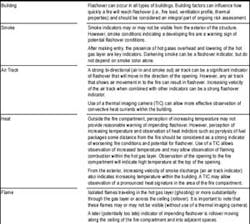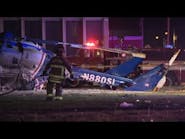Fire Behavior Indicators and Fire Development - Part 1
Previous articles have addressed building factors, smoke, air track, heat, and flame (B-SAHF) as critical fire behavior indicators. Understanding the indicators is important, but more important is the ability to integrate these factors in the process of reading the fire as part of size-up and dynamic risk assessment. This is the first of two articles focused on fire behavior indicators and the stages of fire development.
Compartment Fire Development
Part of the process of reading the fire involves recognizing the stages of fire development that are involved. Remember that fire conditions can vary considerably throughout the building with one compartment containing a fully developed fire, an adjacent compartment in the growth stage, and still other compartments yet uninvolved. Recognizing the stages of fire development and likely progression through this process allows firefighters to predict what will happen next (if action is not taken), potential changes due to unplanned ventilation (such as failure of a window), and the likely effect of tactical action.
Compartment fire development can be described as being comprised of four stages: incipient, growth, fully developed and decay (see Figure 1). Flashover is not a stage of development, but simply a rapid transition between the growth and fully developed stages. (see Figures 1 and 2.)
Review of Fire Behavior Indicators
Firefighters can easily observe some of the B-SAHF indicators. However, fire behavior indicators encompass a wide range of factors that firefighters may see, hear, or feel. Some factors are relatively unchanging (i.e. building construction) and others are quite dynamic, changing as the fire develops (i.e. smoke conditions and flames).
Building: Unlike the other fire behavior factors, the building and its contents are present prior to ignition and can be examined during the preplanning process. While many common types of buildings and occupancies (such as single family dwellings) are not the focus of a formal preplan program, firefighters can examine common features and their influence on fire behavior. This pre-fire assessment of likely fire development and spread should be compared with actual fire behavior encountered during emergency incidents to improve skills in reading building factors.
Smoke and Air Track: Smoke conditions and the pattern of smoke and air movement are two of the most important indicators of fire behavior. The location and appearance of smoke can provide valuable cues related to the location of the fire, its burning regime (fuel or ventilation controlled) and the stage of fire in various areas of the building. It is critical that firefighters begin their assessment of smoke and air track indicators from outside the building, but continue this process on an ongoing basis from both the interior and exterior of the structure.
Heat: While heat cannot be observed directly, observation of the effect of heat on air track (i.e., velocity of smoke discharge), the building or exposures, and sensation of changes in temperature can be significant fire behavior indicators. It is important to remember that our personal protective equipment provides significant insulation and slows the transfer of heat and resulting sensation of changes in temperature.
Flame: Flaming combustion is often the most obvious or visible indicator observed by firefighters. However, do not get so focused on visible flames that you miss more important, but subtle building, smoke, air track, and heat indicators. Flame indicators such as location, volume, color, etc. are important, but need to be integrated into the B-SAHF framework to provide a more complete picture.
Figure 3 integrates the concept maps presented in previous articles and outlines some of the major interrelationships between the B-SHAF fire behavior indicators. (Click Figure 3 for a larger view of the concept map.)
Incipient Stage
Going back to the basics of fire behavior, ignition requires heat, fuel, and oxygen. Once combustion begins, development of an incipient fire is largely dependent on the characteristics and configuration of the fuel involved (fuel controlled fire). Air in the compartment provides adequate oxygen to continue fire development. During this initial phase of fire development, radiant heat warms adjacent fuel and continues the process of pyrolysis. A plume of hot gases and flame rises from the fire and mixes with the cooler air within the room. This transfer of energy begins to increase the overall temperature in the room. As this plume reaches the ceiling, hot gases begin to spread horizontally across the ceiling. Transition beyond the incipient stage is difficult to define in precise terms. However, as flames near the ceiling, the layer of hot gases becomes more clearly defined and increases in volume, the fire has moved beyond its incipient phase and (given adequate oxygen) will continue to grow more quickly.
Depending on the size of the compartment and ventilation profile, there may only be a limited indication (or no indication at all) from the exterior of the building that an incipient stage fire is burning within. Incipient stage indicators are listed in Table 1.
Consider the following situation and how critical fire behavior indicators would present. Use the B-SAHF model to help you frame your answers.
You have responded to a fire in a one-story single family dwelling of wood-frame construction. An incipient fire is burning a bedroom on the Alpha/Bravo corner of the structure. The fire is limited to a plastic trash can containing waste paper which is located next to the bed.
1. What conditions would you expect to see from the exterior of the structure?
2. What indicators may be visible from the front door as you make entry?
3. What might you observe traveling through the living room and down the hallway?
4. What conditions would you find in the bedroom?
It is essential to think about what you are likely to find inside when observing fire behavior indicators from the exterior and performing a risk assessment. After making entry, consider if conditions are different than you anticipated.
5. Why might this be the case?
6. What differences in conditions would be cause for concern?
Growth Stage
If there is adequate oxygen within the compartment additional fuel will become involved and the heat release rate from the fire will increase. While considerably more complex, gas temperatures within the compartment may be described as existing in two layers: A hot layer extending down from the ceiling and a cooler layer down towards the floor. Convection resulting from plume and ceiling jet along with radiant heat from the fire and hot particulates in the smoke increases the temperature of the compartment linings and other items in the compartment.
As gases within the compartment are heated they expand and when confined by the compartment, they increase in pressure. Higher pressure in this layer causes it to push down within the compartment and out through openings. The pressure of the cool gas layer is lower, resulting in inward movement of air from outside the compartment. At the point where these two layers meet, as the hot gases exit through an opening, the pressure is neutral. The interface of the hot and cool gas layers at an opening is commonly referred to as the neutral plane.
The fire can continue to grow through flame spread or by ignition of other fuel within the compartment. As flames in the plume reach the ceiling they will bend and begin to extend horizontally. Pyrolysis products and flammable byproducts of incomplete combustion in the hot gas layer will ignite and continue this horizontal extension across the ceiling. As the fire moves further into the growth stage, the dominant heat transfer mechanism within the fire compartment shifts from convection to radiation. Radiant heat transfer increases heat flux (transfer of thermal energy) at floor level. Growth stage indicators are listed in Table 2.
Returning to the scenario of the residential fire, consider the following situation and how critical fire behavior indicators would present. Use the B-SAHF model to help you frame your answers.
You have responded to a fire in a one-story single family dwelling of wood-frame construction. A growth stage fire is burning a bedroom on the Alpha/Bravo corner of the structure. The fire involves a plastic trash can, the bed, and night stand.
7. What conditions would you expect to see from the exterior of the structure?
8. What indicators may be visible from the front door as you make entry?
9. What indicators would you anticipate observing as you traveled through the living room and down the hallway to the bedroom where the fire is located?
10. What conditions would you find in the bedroom?
As the fire moves through the growth stage, the speed at which conditions change increases rapidly. After making entry, consider if conditions are different than you anticipated?
11. Why might this be the case?
12. What differences in conditions would be cause for concern?
Flashover: Transition to a Fully Developed Fire
Flashover is the sudden transition from a growth stage to fully developed fire. When flashover occurs, there is a rapid transition to a state of total surface involvement of all combustible material within the compartment. Conditions for flashover are defined in a variety of different ways. In general, ceiling temperature in the compartment must reach 500 to 600 C (932 to 1,112 F) or the heat flux (a measure of heat transfer) to the floor of the compartment must reach 15-20 kW/m2 (79.25 Btu/min/ft2)-105.67 Btu/min/ft2). When flashover occurs, burning gases will push out openings in the compartment (such as a door leading to another room) at a substantial velocity.
Recognizing flashover and understanding the mechanisms that cause this extreme fire behavior phenomenon is important. However, the ability to recognize key indicators and predict the probability of flashover is even more important. Indicators of potential or impending flashover are listed in Table 3.
It is important to remember that flashover does not always occur. There must be sufficient fuel and oxygen for the fire to reach flashover. If the initial object that is ignited does not contain sufficient energy (heat of combustion) and does not release it quickly enough (heat release rate), flashover will not occur (e.g., small trash can burning in the middle of a large room). Likewise, if the fire sufficiently depletes the available oxygen, heat release rate will drop and the fire in the compartment will not reach flashover (e.g., small room with sealed windows and the door closed).
Part two of FBI and Fire Development series will examine indicators related to the fully developed and ventilation controlled decay stages of fire development along with a review of ventilation-induced extreme fire behavior.
The fifth edition of the International Fire Service Training Association (IFSTA) Essentials of Firefighting includes an expanded chapter on fire behavior that provides simple, but solid explanation of the fundamentals of fire behavior and dynamics of compartment fire behavior. The second edition of IFSTA Fireground Support Operations (currently under development) will expand on the basic fire behavior information presented in Essentials to address the influence of ventilation on fire behavior, fire behavior indicators, and reading the fire.
Do you have a good photograph or video clip illustrating building, smoke, air track, heat, or flame indicators? If you do and would be willing to share it, please send a copy to [email protected]. I will be working to include photographs and video clips in future articles to provide you with an opportunity to apply your knowledge of fire behavior and skill in reading the fire.
Related Firehouse.com Articles
- Fire Development in a Compartment Part 1
- Fire Development in a Compartment Part 2
- Smoke Burns
- Reading the Fire: Building Factors
- Reading the Fire: Smoke and Air Track
- Reading the Fire: Heat and Flame
ED HARTIN, M.S., EFO, MIFireE, CFO, a Firehouse.com Contributing Editor, is a Battalion Chief with Gresham, OR, Fire and Emergency Services. Ed has a longstanding interest in fire behavior and has traveled internationally, studying fire behavior and firefighting best practices in Sweden, the UK, and Australia. Along with Paul Grimwood (UK), Shan Raffel and John McDonough (Australia), Ed co-authored 3D Firefighting: Techniques, Tips, and Tactics. The International Association of Fire Chiefs (IAFC), at its 2006 annual conference, recognized Gresham Fire and Emergency Services compartment fire behavior training (CFBT) program as a finalist for an Award of Excellence. At the same conference, the Commission on Fire Accreditation International awarded Ed a Chief Fire Officer (CFO) designation. To read Ed's complete biography and view their archived articles, click here. You can reach Ed by e-mail at [email protected].

Edward Hartin | Editoral Staff
Ed Hartin, MS, EFO, FIFireE, CFO has over 40 years as a career firefighter and fire officer and currently serves as fire chief with Central Whidbey Island Fire & Rescue. Hartin is also a member of the UL Firefighter Safety Research Institute Advisory Board and vice president of the USA Branch of the Institution of Fire Engineers.






